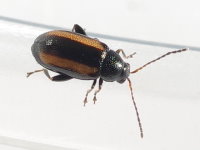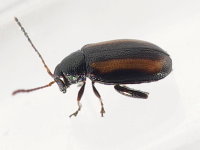Phylum Arthropoda (Arthropods) ➔ Subphylum Hexapoda (Hexapods) ➔ Class Insecta (Insects) ➔ Order Coleoptera (Beetles) ➔ Family Chrysomelidae (Leaf beetles)
Phyllotreta vittula (Redtenbacher, 1849)
Gebänderter Getreideerdfloh Barley Flea Beetle
Classification:
Phyllotreta vittula belongs to the subfamily Galerucinae, tribe Alticini.Distribution:
Widespread and frequent in Central Europe.Habitat:
Ruderal areas, farmland, sonny grassland.Description:
Small dark beetle with a body length of 1.5 - 1.8 mm and metallic shiny head and pronotum. The elytra have a yellow, almost equally wide longitudinal stripe. Tibia and tarsi are usually black, the joints lighter.There are several similar species.
Biology:
Phyllotreta vittula forms one generation per year. The wintered imagines appear at the end of March and start to eat their host plants. Mating season is end of April and May. The females lay their eggs in the ground at a depth of 1 to 4 cm. The hatched larvae feed on roots. They reach a length of up to 3.5 mm. The pupation takes place in the soil. After a pupal period of 2 weeks the imagines of the new generation appear at the beginning of July. These often hibernate in forests or other protected places after maturation feeding.Phyllotreta vittula lives mainly on grasses (Poaceae) and prefers the couch grass (Elytrigia repens) as a food plant, but also accepts crucifers (Brassicaceae) and some members of other plant families.
References, further reading, links:
- Arved Lompe: Die Käfer Europas - Ein Bestimmungswerk im Internet
- Interactive Agricultural Ecological Atlas of Russia and Neighboring Countries. Economic plants and their Diseases, Pests and Weeds
- Rheinheimer, Joachim, & Hassler, Michael: Die Blattkäfer Baden-Württembergs, 2018, 928 pages, Kleinsteuber Books (Karlsruhe), ISBN 978-3-9818110-2-5
- Agelastica alni
- Altica sp.
- Aphthona nonstriata
- Bromius obscurus
- Bruchus rufimanus
- Bruchus sp.
- Cassida nebulosa
- Cassida rubiginosa
- Cassida sp.
- Cassida stigmatica
- Cassida vibex
- Cassida vibex/bergeali
- Cassida viridis
- Chrysolina fastuosa
- Chrysolina haemoptera
- Chrysolina hyperici
- Chrysolina lucidicollis
- Chrysolina oricalcia
- Chrysolina sp.
- Chrysolina sturmi
- Chrysolina varians
- Chrysomela populi
- Chrysomela tremula
- Chrysomela vigintipunctata
- Clytra laeviuscula
- Clytra quadripunctata
- Coptocephala sp.
- Crepidodera aurata
- Crepidodera aurea
- Crepidodera fulvicornis
- Crioceris duodecimpunctata
- Cryptocephalinae sp.
- Cryptocephalus moraei
- Cryptocephalus nitidus
- Cryptocephalus pusillus
- Cryptocephalus sp.
- Donacia bicolora
- Donacia cinerea
- Donacia marginata
- Donacia versicolorea
- Galeruca tanaceti
- Galerucella s.l.
- Gastrophysa viridula
- Gonioctena decemnotata
- Gonioctena quinquepunctata
- Gonioctena quinquepunctata/intermedia
- Gonioctena sp.
- Gonioctena viminalis
- Lema cyanella
- Leptinotarsa decemlineata
- Lilioceris lilii
- Lochmaea caprea
- Neocrepidodera ferruginea
- Neocrepidodera sp.
- Oulema melanopus/duftschmidi
- Oulema obscura
- Pachybrachis sp.
- Phratora sp.
- Phratora vitellinae
- Phyllobrotica quadrimaculata
- Phyllotreta armoraciae
- Phyllotreta nemorum
- Phyllotreta vittula
- Plagiodera versicolora
- Plagiosterna aenea
- Plateumaris sp.
- Podagrica fuscicornis
- Psylliodes sp.
- Pyrrhalta viburni
- Sphaeroderma sp.
- Xanthogaleruca luteola

